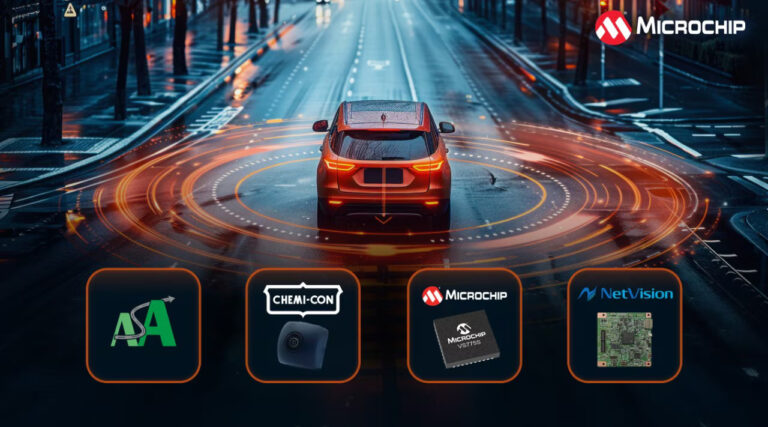Microchip Technology has partnered with Nippon Chemi-Con and NetVision to launch the first Automotive SerDes Alliance Motion Link (ASA-ML) camera development platform in the Japanese automotive market. This joint solution aims to simplify and accelerate ASA-ML adoption for advanced driver-assistance systems (ADAS) by offering a scalable, standards-based ecosystem.
The platform leverages the ASA-ML standard’s high-speed, asymmetric data transmission capabilities while supporting hardware-based link-layer security to meet emerging automotive cybersecurity requirements.
“We were first to market with an ASA-ML chipset through our acquisition of VSI, and now we have collaborated with pioneers like Nippon Chemi-Con and NetVision to deliver the first camera development ecosystem that reduces risk and speeds ASA-ML adoption for Japanese OEMs,” said Kevin So, vice president of Microchip’s communications business unit.
“Nippon Chemi-Con’s CDTrans camera module and NetVision’s NV061 development emulation board are both based on our VS775S single-port serializer/deserializer device, further demonstrating the industry’s commitment to a standardized ASA-ML solution for Japanese automotive OEMs as they embrace the rapid growth of camera-based ADAS systems driven by the need for safety and convenience.”
“We are excited to collaborate with an automotive semiconductor market leader like Microchip in offering Japanese OEMs another important first with our new CDTrans ASA-ML-based automotive camera module that is integrated with the VS775S serializer,” commented Katsunori Nogami, managing executive officer, chief technology officer with Nippon Chemi-Con.
“We recognize the importance and benefit of open standards-based connectivity technologies like ASA-ML that automotive Tier 1 suppliers and OEMs need for interoperable multi-vendor solutions. This collaboration is a key step in accelerating ASA-ML adoption for next-generation ADAS camera systems in Japan’s rapidly evolving SDV landscape. Combined with NetVision’s well recognized camera test and emulation platform, our camera module will enable cross-vendor compatibility, future-proof scalability and a pathway beyond closed systems.”
“Partnering with Microchip and Nippon Chemi-Con on this new ASA-ML ecosystem platform will help realize a standardized and scalable electrical/electronic in-vehicle networking architecture for Japan’s SDV era,” added Kenji Kudo, engineering department director at NetVision.
“Our development of a VS775S based ASA-ML serializer connection board coupled to our unique camera emulation development platform for ADAS ECUs will help remove a key barrier to adoption for many Japanese OEMs and Tier 1s who have been hampered by proprietary connectivity protocols that limit interoperability and scalability. We look forward to continued collaboration on advancing the ASA-ML ecosystem.”
Multi-vendor solutions are now essential for managing supply-chain risk in the automotive industry. OEMs and Tier 1 suppliers prioritize sourcing flexibility and long-term resilience, especially for L2 and L2+ autonomous systems, which require more cameras and sensors. These demands highlight the need for scalable, flexible, interoperable and high-bandwidth connectivity solutions that avoid the limitations of closed, single-vendor ecosystems.
An automotive industry transition is underway to replace proprietary camera connectivity with solutions based on the open and interoperable ASA-ML standard, which is driven by over 150 member companies worldwide. OEMs adopting camera solutions based on a new standard like ASA-ML require development tools, emulation platforms and broad supply chain support.
Microchip’s VS775S single-port ASA-ML serializer/deserializer aims to address this issue as a standards-compliant, asymmetric, scalable-bandwidth video support system platform. The platform enables Nippon Chemi-Con to create an ecosystem-ready camera module for the Japanese automotive market. The camera emulation and development platform from NetVision uses the Microchip VS775S to simplify development and verification. This is done by enabling efficient evaluation of video signal quality during the design of camera modules and engine control units (ECUs). The platform enables video signals to be captured in real time, leveraging Microchip’s VS775S evaluation board.
In related news, Continental’s automotive sector has established the Advanced Electronics & Semiconductor Solutions (AESS) organization, for the design and verification of automotive semiconductors with a view to fulfilling demand internally. Read the full story here


